Contents
Features
Case Sharing
Legal Knowledge
Did You Know
Statistics
Message from the Editor
Hello, everyone! This issue of Gas Safety Bulletin features the online booking for vehicle examination of LPG cylinder wagons, points to note on regular safety inspection of LPG installations in domestic premises, points to note for carrying out works on gas pipes, supply and regulation of natural gas in Hong Kong, avoidance of damage to underground gas pipes, requirements of five-yearly inspection of LPG vehicle fuel tanks, and requirements of personnel carrying out gas installation works. What's more, legal knowledge about gas safety, as well as gas-related incidents and prosecution statistics by type in January to December 2020 are included for reference.
Feature 1
Online Booking Service for Vehicle Examination of LPG Cylinder Wagons Has Been Launched
The new online booking service for vehicle examination of LPG cylinder wagons launched by the Gas Standards Office has been officially opened for use by applicants for LPG cylinder wagon permits since 16 December 2020.
 Whether it is application for a new permit (new permit) or renewal of an existing permit every 12 months (renewed permit) for a LPG cylinder wagon, its owner must make a booking with the EMSD for vehicle examination. A permit will be issued to the wagon only upon confirmation that the wagon complies with the requirements stipulated in Gas Utilisation Guidance Note 10 - Code of Practice for the Design and Construction of LPG Cylinder Wagon.
Whether it is application for a new permit (new permit) or renewal of an existing permit every 12 months (renewed permit) for a LPG cylinder wagon, its owner must make a booking with the EMSD for vehicle examination. A permit will be issued to the wagon only upon confirmation that the wagon complies with the requirements stipulated in Gas Utilisation Guidance Note 10 - Code of Practice for the Design and Construction of LPG Cylinder Wagon.
In order to enhance service quality and save applicants' waiting time, the EMSD launches a new online booking system to gradually replace the telephone booking service which has been provided for some time.
As in the past, an applicant of a new permit or a renewed permit must first submit an application form and the required supporting documents, and then books the date for vehicle examination. Regarding application for renewed permits, the EMSD only accepts booking for vehicle examination regarding existing permits that will expire within 3 months. The EMSD will confirm the booking by notifying the applicant by phone or email within 5 working days after receiving the booking.
After the launch of the online booking service, the EMSD will continue to provide telephone booking service until further notice.
Online booking provides more flexible and faster service
Feature 2
Points to Note on Regular Safety Inspection of LPG Installations in Domestic Premises
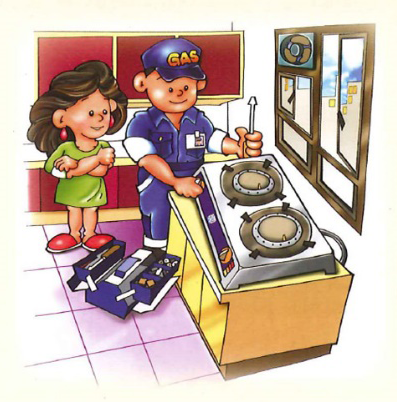 Hong Kong is one of the most densely populated cities in the world and there are various types of liquefied petroleum gas (LPG) installations in different domestic buildings. In the event of gas leakage, fire and explosion may occur and affect other households, resulting in danger to life and property. If LPG installations and pipework pose danger due to lack of maintenance, the registered gas supply companies may suspend gas supply for safety reasons. As precautionary measures, the registered gas supply companies conduct regular safety inspections at domestic buildings that use piped LPG at least once every 18 months, so as to ensure that the LPG installations in domestic premises are operating safely and in good order. The households shall make corresponding arrangements for the inspections. What do you know about the regular safety inspection?
Hong Kong is one of the most densely populated cities in the world and there are various types of liquefied petroleum gas (LPG) installations in different domestic buildings. In the event of gas leakage, fire and explosion may occur and affect other households, resulting in danger to life and property. If LPG installations and pipework pose danger due to lack of maintenance, the registered gas supply companies may suspend gas supply for safety reasons. As precautionary measures, the registered gas supply companies conduct regular safety inspections at domestic buildings that use piped LPG at least once every 18 months, so as to ensure that the LPG installations in domestic premises are operating safely and in good order. The households shall make corresponding arrangements for the inspections. What do you know about the regular safety inspection?
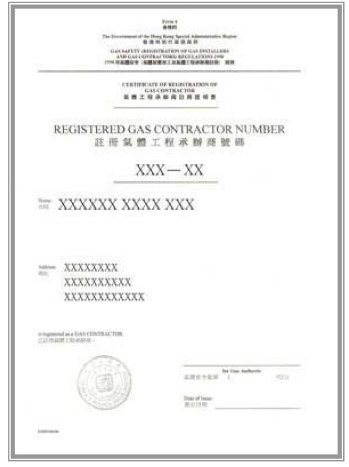 Certificate of registration of a registered gas contractor
Certificate of registration of a registered gas contractor
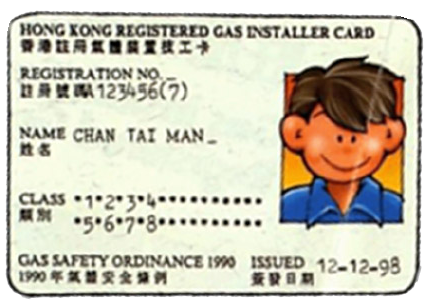 Registered gas installer card of a registered gas installer
Registered gas installer card of a registered gas installer
Regular safety inspections of LPG installations in domestic premises aim to ensure the safe operation of the installations and minimise the risk of gas leakage. The registered gas supply companies will liaise with the property management companies and confirm in writing the dates and times of the regular safety inspection. Notices on the inspection will also be displayed at prominent positions in the lobbies of the domestic buildings so that households could reserve time accordingly. For enquiries on the dates and times of the inspection, please contact the registered gas supply companies directly for further arrangements.
According to the law, only registered gas installers employed by registered gas contractors can carry out safety inspections of LPG installations. Such contractors shall display the certificate of registration and relevant notices at their places of business. The list of registered gas contractors is also available on the EMSD's website for public reference. Moreover, households should take note of the registered gas installer cards of the gas installers for verification. If in doubt, household should contact the registered gas contractors, the registered gas supply companies or the property management companies for follow-up actions.
The wide scope of the regular safety inspection of LPG installations covers indoor and outdoor LPG pipework, gas fittings connecting the LPG pipework and the relevant control valves, flexible LPG tubing, gas appliances such as LPG cooking appliances and water heaters, etc.
During the regular safety inspection, the registered gas supply companies will inspect the indoor and outdoor LPG pipework. Households may proactively consult their estate management offices about the locations of the gas pipework installed inside the floors or walls. The registered gas supply companies will also inspect the space above false ceilings for trapped LPG, so as to minimise the risk of LPG leakage.
Upon completion of the regular safety inspection, the contractors will provide the households with the relevant work records, which include the inspection details, recommendations on maintenance works, as well as the names and registration numbers of the gas installers. The work records should be kept by the households properly to protect their own interests and arrange the next inspection. If irregularities are found, household should contact the registered gas contractor as soon as possible for follow-up actions.
To ensure that the LPG installations in domestic premises are operating safely and in good order, and minimise the risk of installation faults and gas incidents, please arrange registered gas supply company to conduct regular safety inspection of LPG installations at least once every 18 months.
Feature 3
Supply and Regulation of Natural Gas in Hong Kong
Natural gas
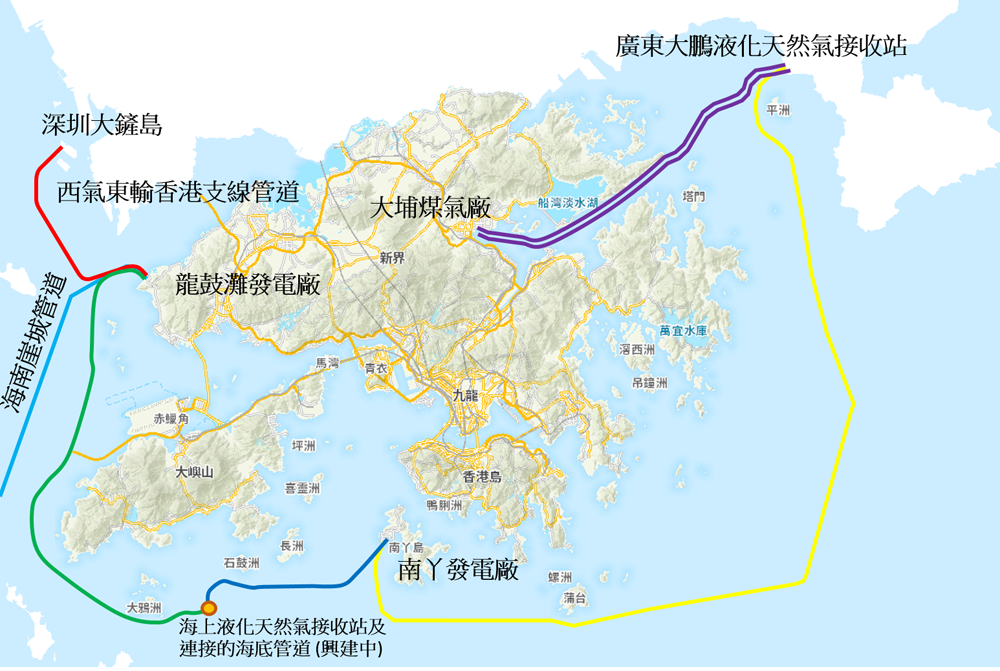 Subsea pipelines of natural gas in Hong Kong
Subsea pipelines of natural gas in Hong Kong
(Traditional Chinese version)
Natural gas is a relatively clean fossil fuel that primarily consists of methane. At present, the Hong Kong and China Gas Company Limited, the Hongkong Electric Company Limited (HEC) and CLP Power Hong Kong Limited (CLP Power) import natural gas to Hong Kong via subsea pipelines from Guangdong Dapeng LNG Receiving Terminal, Yacheng of Hainan and Dachan Island of Shenzhen (Second West-East Natural Gas Pipeline) for the production of town gas and electricity generation. In support of the government's policy to increase the use of natural gas for power generation to reduce carbon emissions, an offshore Liquefied Natural Gas (LNG) terminal is currently under construction by the CLP Power and HEC in the southern waters of Hong Kong. Using the technology of the Floating Storage and Regasification Unit and subsea pipelines, the LNG terminal will enhance the stability and flexibility of natural gas supply in Hong Kong.
In accordance with the Gas Safety Ordinance (Cap. 51), natural gas supply facilities, including the receiving terminals, pressure-regulating installations, high-pressure transmission pipelines, etc., are notifiable gas installations, the construction and use of which require approval from the Gas Authority.
Biogas
Organic waste contains a treasure trove of valuable resources. Not only can food waste recycling turn waste into energy, it can also reduce the need for dumping waste at landfills, thereby contributing to extending the useful life of landfills in Hong Kong. To complement the development of food waste recycling in Hong Kong, the Organic Resources Recovery Centre Phase 1 (ORRC1), located at Siu Ho Wan of Lantau Island, has commenced full operation since July 2018. The Organic Resources Recovery Centre Phase 2 (ORRC2) located at Sha Ling in North District is currently under construction and expected to be commissioned in 2022. The ORRC1 and ORRC2 will have a total daily treatment capacity of 500 tonnes of organic waste.
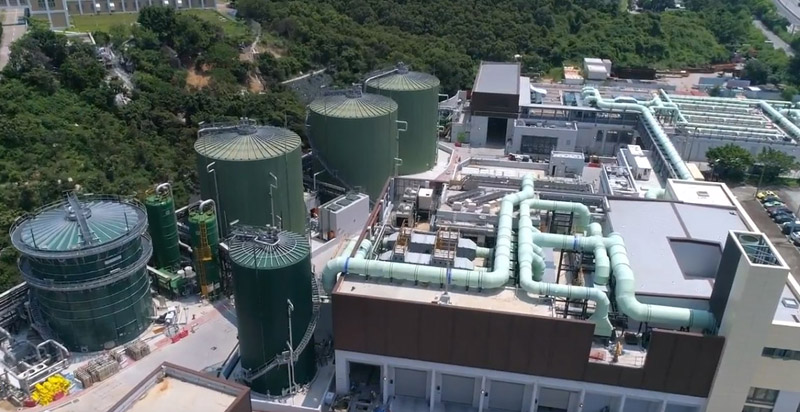 The ORRC1 located at Siu Ho Wan of Lantau Island
The ORRC1 located at Siu Ho Wan of Lantau Island
The Organic Resources Recovery Centres (ORRCs) adopt anaerobic digestion technology to convert food waste into biogas for electricity generation, reducing the use of fossil fuel. The decomposed residues can be produced as compost for landscaping and agriculture use. When the ORRC1 operates in the designed capacity, about 14 million kWh of electricity can be exported to the grid every year, which is equivalent to the power consumption by some 3 000 households, and some 25 000 tonnes of greenhouse gas emissions can be reduced.
In accordance with the Gas Safety Ordinance (Cap. 51), biogas is synthetic natural gas and its related gas installations are notifiable gas installations, the construction and use of which require approval from the Gas Authority.
Safety and Inspection of notifiable gas installations
In accordance with the Gas Safety (Gas Supply) Regulations (Cap. 51B), the owner of a notifiable gas installation, including power companies, Towngas and the operators of the ORRCs, shall maintain and operate the installation in a safe condition for the prevention of fire, explosion or other danger arising from the installation. In addition, the owner shall ensure that the inspection of the notifiable gas installation is carried out by competent persons.
Case Sharing
Avoidance of Damage to Underground Gas Pipes
In the past, there were occasional incidents of damage to under-ground gas pipes during the course of works involving excavation or other means of penetrating the ground at or below surface level, leading to gas leaks or fires, etc., which may also disrupt gas supply to the surrounding area, thereby causing great inconvenience to the general public. The works contractors involved may be charged for contravening the requirements of section 23A of the Gas Safety (Gas Supply) Regulations (Cap. 51B).
To ensure gas safety, when carrying out any works that may bear upon underground gas pipes, works contractor should take appropriate steps and measures to avoid damage to gas pipes, including:
Before commencement of works
- Obtain layout plans and relevant information of the underground gas pipes within and in the vicinity of the works area from registered gas supply companies.
- Use pipe locators to identify the alignment and depth of gas pipes by trained and experienced personnel and provide the persons carrying out the works with the underground gas pipe survey records.
- Dig trial holes to confirm the positions of gas pipes.
- After locating the pipes, mark their alignment and depth on the road surface clearly.
- Ensure that the persons who carry out the works can access the information of the positions of gas pipes and understand clearly the safety precautions required.
In the course of works
- Maintain adequate safety clearance from the underground gas pipes and take the following measures during excavation:
- Use hand tools to excavate.
- Be aware of the markings/warning tapes on the road surface regarding the positions of gas pipes.
- Excavate from the sides of gas pipes rather than on top of them as far as possible.
- Dig horizontally to expose the gas pipes.
- Keep a minimum clearance of one metre from both sides of a gas pipe when using machines.
- Provide sufficient support to exposed underground gas pipes and provide proper backfilling where appropriate.
- If you are not sure of the type of a pipe, always assume that it is in use and that it may be hazardous.
Legal Knowledge
Re-examination must be Carried out Once Every Five Years for Fuel Tanks of LPG Vehicles
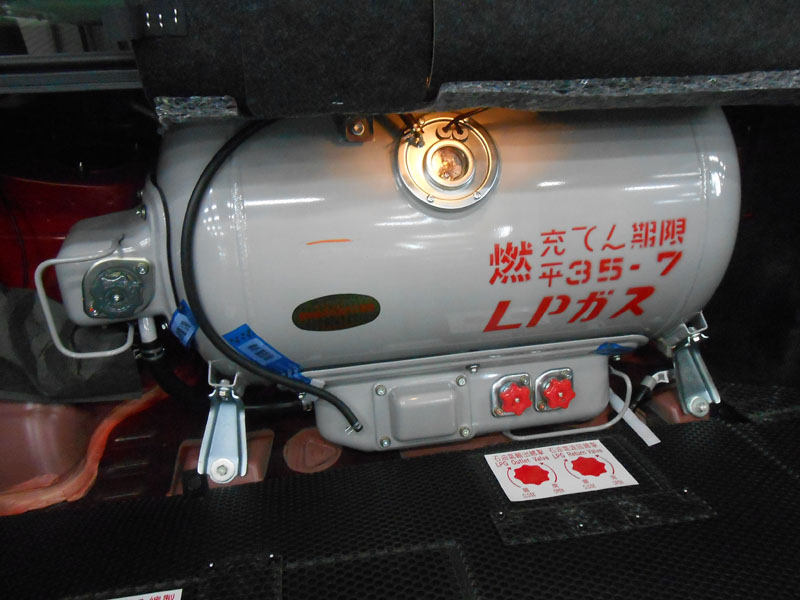
According to the Gas Safety (Gas Supply) Regulations (Cap. 51B), the owner of a fuel tank shall not use the fuel tank to contain liquefied petroleum gas unless the fuel tank has been tested and examined not less than once in the 5 years period immediately preceding such use to ascertain whether the fuel tank is safe to be so used. An owner of an LPG vehicle should pay attention to the expiry date of the examination of the fuel tank of his vehicle and arrange for a re-examination of the fuel tank as soon as possible accordingly. If the re-examination is carried out after the expiry date, the owner contravenes the requirements of the Gas Safety Ordinance and is liable on conviction to a fine of $10,000 and, in the case of a continuing offence, to a daily penalty of $1,000.
Did You Know
Gas Installation Work Must be Carried Out by a Registered Gas Installer who is Also or is Employed by a Registered Gas Contractor
According to the Gas Safety (Registration of Gas Installers and Gas Contractors) Regulations, no person other than a registered gas installer who is a registered gas contractor or the employee of a registered gas contractor, shall personally carry out any gas installation work except in the following cases:
- A registered gas installer personally carries out gas installation work of a class in respect of which he is so registered and in domestic premises occupied by him; or
- An individual who is undergoing training for the purpose of satisfying any requirements necessary to qualify him for the issue of a registration card personally carries out any gas installation work and, in relation to such work, he is under the supervision of a registered gas installer.
Therefore, a registered gas installer is not allowed to undertake and carry out gas installation work in the capacity of a self-employed person. A registered gas installer employed by a registered gas contractor shall only be engaged in gas installation work of a class in respect of which he is so registered. Otherwise, he commits an offence and is liable on conviction to a fine of $25,000 and to imprisonment for 6 months and, in the case of a continuing offence, to a daily penalty of $2,000.
Besides, a registered gas installer carrying out any gas installation work must, on request by any person, produce his registration card or an equivalent document to the person. Otherwise, he commits an offence and is liable on conviction to a fine of $1,000.
Gas-related Incident and Prosecution Statistics by Type

Gas-related Incidents by Type in 2020 (January to December)
| Gas fittings/appliances (23 cases) |
| Services pipes (89 cases) |
| Gas main pipes (19 cases) |
| Installation pipes (26 cases) |
| Others (22 cases) |
Prosecutions by Type for Gas-related Cases in 2020 (January to December)
| Using containers that have not been approved in writing by the Gas Authority to contain LPG (4 cases) |
| Late examination of LPG cylinders / fuel tanks of LPG vehicles (7 cases) |
| Non-registered gas contractors/installers personally carrying out gas installation works (1 case) |
| Storing excessive LPG (18 cases) |
| Breaching permit conditions of gas vehicles (9 cases) |
| Damaging risers / underground gas pipes (11 cases) |
| Supplying/storing/carrying LPG cylinders without approval by registered gas supply companies (8 cases) |
| Others (2 cases) |
Contact Information
Gas Authority, EMSD
Information for the Gas Trade
 [PDF format (1.44MB)]
[PDF format (1.44MB)] Whether it is application for a new permit (new permit) or renewal of an existing permit every 12 months (renewed permit) for a LPG cylinder wagon, its owner must make a booking with the EMSD for vehicle examination. A permit will be issued to the wagon only upon confirmation that the wagon complies with the requirements stipulated in Gas Utilisation Guidance Note 10 - Code of Practice for the Design and Construction of LPG Cylinder Wagon.
Whether it is application for a new permit (new permit) or renewal of an existing permit every 12 months (renewed permit) for a LPG cylinder wagon, its owner must make a booking with the EMSD for vehicle examination. A permit will be issued to the wagon only upon confirmation that the wagon complies with the requirements stipulated in Gas Utilisation Guidance Note 10 - Code of Practice for the Design and Construction of LPG Cylinder Wagon.

 Scan the QR code to enter the system
Scan the QR code to enter the system Hong Kong is one of the most densely populated cities in the world and there are various types of liquefied petroleum gas (LPG) installations in different domestic buildings. In the event of gas leakage, fire and explosion may occur and affect other households, resulting in danger to life and property. If LPG installations and pipework pose danger due to lack of maintenance, the registered gas supply companies may suspend gas supply for safety reasons. As precautionary measures, the registered gas supply companies conduct regular safety inspections at domestic buildings that use piped LPG at least once every 18 months, so as to ensure that the LPG installations in domestic premises are operating safely and in good order. The households shall make corresponding arrangements for the inspections. What do you know about the regular safety inspection?
Hong Kong is one of the most densely populated cities in the world and there are various types of liquefied petroleum gas (LPG) installations in different domestic buildings. In the event of gas leakage, fire and explosion may occur and affect other households, resulting in danger to life and property. If LPG installations and pipework pose danger due to lack of maintenance, the registered gas supply companies may suspend gas supply for safety reasons. As precautionary measures, the registered gas supply companies conduct regular safety inspections at domestic buildings that use piped LPG at least once every 18 months, so as to ensure that the LPG installations in domestic premises are operating safely and in good order. The households shall make corresponding arrangements for the inspections. What do you know about the regular safety inspection? Certificate of registration of a registered gas contractor
Certificate of registration of a registered gas contractor Registered gas installer card of a registered gas installer
Registered gas installer card of a registered gas installer
 Subsea pipelines of natural gas in Hong Kong
Subsea pipelines of natural gas in Hong Kong The ORRC1 located at Siu Ho Wan of Lantau Island
The ORRC1 located at Siu Ho Wan of Lantau Island.png) For avoidance of damage to gas pipes, the EMSD issued the Code of Practice on Avoiding Danger from Gas Pipes (CoP) for reference by the trade in 1997. It was reviewed and revised in 2018 so as to fully enhance the requirements on safe system of work and protect the safety of the trade and the public.
For avoidance of damage to gas pipes, the EMSD issued the Code of Practice on Avoiding Danger from Gas Pipes (CoP) for reference by the trade in 1997. It was reviewed and revised in 2018 so as to fully enhance the requirements on safe system of work and protect the safety of the trade and the public.